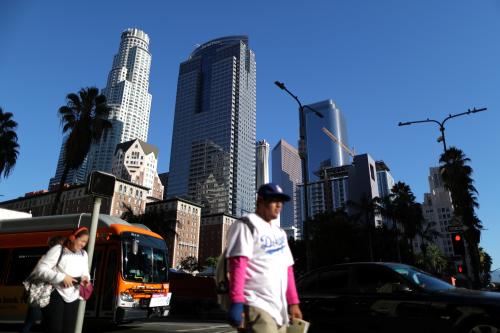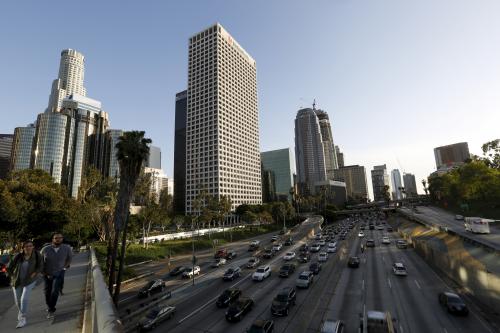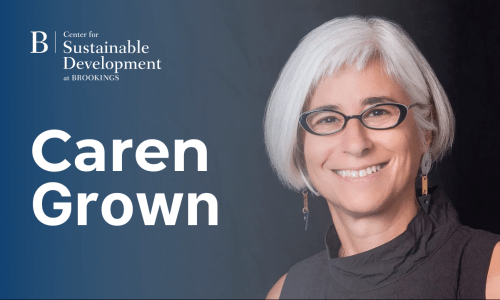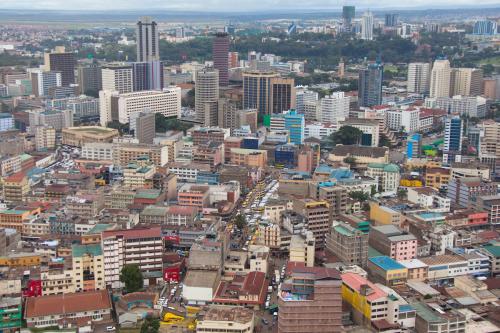When countries adopted the Sustainable Development Goals (SDGs) in 2015, the inclusion of SDG 11 highlighted the importance of urbanization to sustainable development, and committed national governments to support cities in becoming more inclusive and resilient.
Four years in, it is clear that cities matter for much more than SDG 11. Mayors and local government officials are demonstrating that cities form the front lines of SDG success, as they translate the agenda’s global aspirations into a blueprint for local progress.
Recently, the Brookings Institution held a private gathering of senior government officials whose cities are in the vanguard of localizing the SDGs. The setting provided an unusual opportunity for these city leaders to share their challenges, best practices, and innovations, and—as outlined in our new brief—to define a city-specific perspective on the value of the SDGs and what it will take for local implementation to go to scale.
The cities that participated in the gathering stressed that their citizens view them as responsible for progress on all its dimensions, even if they don’t have jurisdiction over all its issues. The officials were less concerned about strict fidelity to 17 goals and 169 targets than about holding themselves accountable to the agenda’s social, economic, and environmental considerations all at once.
Alignment between city strategies and priorities happens in flexible ways: Los Angeles is developing a public dashboard after comparing its city plans and executive directives against the SDGs, while Accra is seeking to fit its local efforts into the national development plan. New York and Helsinki are showing how alignment can lead to accountability by developing and advocating for the creation of Voluntary Local Reviews (VLRs).
Cities are also proving to be the laboratories for SDG innovation. Bristol and Malmo, for example, are modifying their procurement policies to reflect SDG priorities. In Bristol, social value is part of the decisionmaking process, accounting for 20 percent of the final contract valuation. Madrid is experimenting with a venture capital-like fund to support new scalable initiatives; Durban is taking on the development challenges of rural areas within its city limits; and Mexico City is seeking new types of partnerships with business as it pursues cleaner air and higher quality jobs.
Local progress on the SDGs requires new models of governance, which cities are using to attract and coordinate the efforts of local stakeholders. Mannheim and Milan have engaged citizens and youth in civic planning and programs, and Yokohama’s business-to-business platform is spreading tested solutions to others. Pittsburgh is developing a platform to coordinate local businesses, philanthropy, civil society, and universities and Orlando is using the SDGs as the basis for a new regional resilience plan across eight counties and more than 40 towns.
Serious local implementation will not go to scale if cities see the SDGs primarily as a compliance exercise or yet another reporting framework. The cities that gathered are embracing the SDGs because of the worth they provide to their citizens. The themes that run through these initiatives are indicative of the utility of the SDGs for cities:
- Making data a cornerstone for cities and their constituents. SDG cities are using data to develop evidence-based policy, and investments from donors are needed to strengthen their data capacity. Exploration of a data floor common to all cities undertaking the SDGs would encourage comparability across cities. The Voluntary Local Review (VLR), a concept pioneered by New York City, is sparking an international movement as an instrument for aligning city strategies to the SDGs. Flexibility in its format will accelerate widespread adoption, but a set of widely accepted principles could maintain the VLR’s credibility.
- Financing and shaping the market to meet city-specific SDG needs. Cities are interested in using commitments to the SDGs to unlock new streams of financing, but it’s not always easy to know what types of investments and products are available, and how investors will use the SDGs to manage risk or seek out new projects. There is also an appetite to explore how procurement policies can reflect SDG priorities, and even use collective purchasing in order to shape the market. Cities would benefit from catalytic resources (whether public or philanthropic) to build their capacity to pursue these opportunities.
- Building new models of local governance. City governments do not have sufficient resources and capacity to achieve their goals, and SDG localization provides an opportunity to pull together contributions from multiple stakeholders in the city. Enabling the dissemination of successful models, and drawing upon lessons and analysis of what works, will be important for initiating collaboration and helping cities manage across sectors, partners, and different levels of government.
While these leaders noted the potential of their individual cities to deliver on the SDGs, they also recognized the strength in numbers. Integrating the SDGs into the city-to-city networks in which they participate will, by sharing best practices and innovations, help to leverage needed capabilities. It will also provide a platform for elevating their voice in debates about the SDGs.
The universal application of the SDGs was one of the most revolutionary aspects of the 2015 agreement, committing all nations—both developed and developing—to achievement of the goals. The cities that have come together are large and small, from the North and South, from developed and developing countries. At Bellagio, their energy, pragmatism, and commitment to solutions were on full display, and the sharing of problems and solutions went both ways. Cities may prove themselves to be the standard-bearers in fulfilling the promise of universality.







Commentary
Cities: The labs for Sustainable Development Goal innovation
June 18, 2019